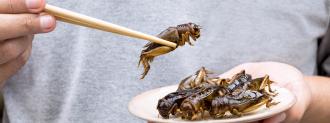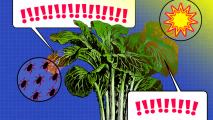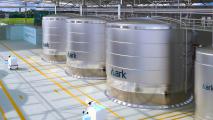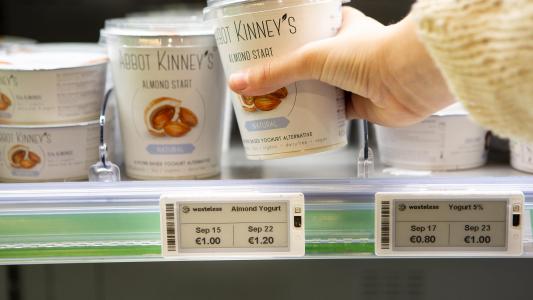Worldwide, the demand for meat and protein is rising, and we need to find sustainable ways to meet those needs.
Bug enthusiasts say that edible insects can more than make up for the world’s protein deficiency, while cleaning up waste and using fewer resources — a win-win-win.
So, would you eat an insect if it would help save the world? The answer is “Obvs,” right?
Insects have been a staple cuisine throughout human history. But in the West, because of a strong “ick-factor” conjured up at the thought of biting down on a creepy-crawly — edible insects are reserved for posh meat-free choices at eco-restaurants.
Thankfully, we don’t need to eat the little beasties. We can feed them to animals instead.
Grasshoppers Are a Gateway Bug for Food Sustainability
Aly Moore counts herself lucky that her first bug-eating experience was with a “chapuline,” a type of grasshopper commonly seasoned with chilli and lime in Mexico. She was there for a study abroad program. But it was sampling the insect that changed her life.
“The curiosity it sparked in me was the most important thing. It was also super delicious,” she says.
Since then, Moore has become a bug-eating icon, a blogging champion of minibeasts — encouraging people to overcome their fears and eat bugs. More importantly, she educates people on the health and planetary benefits of incorporating insect protein into human and animal diets.
Moore has witnessed people overcome the squeamish feelings and crunch down on a cricket or beetle at the “bug and wine” pairing events she hosts. She has helped Girl Scouts earn badges for incorporating cricket flour while baking cookies (don’t worry, there aren’t any insects in your favorite Girl Scout cookies…yet).
But she says it is still a long way off before edible insects become standard American fare. Moore says another way to address the food sustainability crisis is to feed insects to farm animals and fish, instead. After all, animals eat insects in the wild already.
The World Is Protein Deficient, but Insects Are Protein Rich
According to the World Resources Institute, by 2050, global meat and dairy will increase by nearly 70 percent, with beef consumption increasing by more than 80 percent.
At this rate, our ability to produce food will need to increase rapidly to meet the demands of the world’s growing population.
Globally, 20% of protein is consumed by livestock, and on average, only about 8.3% of that plant protein is converted into animal protein. Some studies found the feed-to-food conversion rate for beef even lower, at 2.5%. That means it could take as much as 10 to 40 pounds of feed protein to produce a pound of meat.
But, with insects, the conversion rate is much greater. Just one pound of feed will produce one pound of insect protein.
“It’s just inevitable that these bugs are going to become a huge portion of our protein supply. It’s a matter of whether we can get it done in five years or 25,” says Tequila Ray Snorkel, an engineer at Ovipost, an insect farm in Florida that primarily raises crickets for pet food.
Snorkel also says there is a tremendous opportunity to replace fishmeal — a powdery feed made from fish, primarily used to feed farmed animals and fish — with insects. Because fishmeal contains valuable omega-3 fatty acids, it is often incorporated into dietary supplements, dog food, chicken meal, farm-raised fish food, and other animal feeds.
Often fishmeal comes from bunker or menhaden, or other small fish that are critical to the food web. The menhaden fishery has seen some controversy as conservationists say populations are in a sharp decline, and the massive nets threaten other sea life, even endangered animals.
“The only way we get those (fish) for as cheap as we get them is to pretty much steal them out of the ocean,” Snorkel says. “The people who raise farm fish are feeding them fishmeal right now. They really don’t want to be, because the whole point of farming fish is to not over-fish the oceans.”
Snorkel adds that an additional benefit to feeding insects to farmed fish is that they aren’t exposed to the mercury often found in seafood. She describes using fishmeal as “short-circuiting the whole advantage” of an aquaculture.
Major chains are making food sustainability commitments by incorporating insect feed into their supply chain. For example, to meet the quality standards of seafood at Whole Foods, fish must meet the “Fish In, Fish Out Ratio,” which is set to achieve their goal to “reduce pressure on populations of wild fish and to decrease reliance on reduction fisheries for feed.” It recommends insects as a replacement for fishmeal. And even McDonald’s is exploring the use of insects as chicken feed for their products.
But insect farms can’t yet compete with fishmeal on price or scale. Snorkel says that it will happen if and when insect farms reduce production costs — most of the expenses associated with raising crickets go towards labor. Snorkel is working on designing new automation technology to reduce human labor.
Fishmeal aside, Snorkel says there are even more significant benefits to farming insects.
“We have hugely under-researched insects. They are the majority of biomass on land, and we know very little about them. Just being able to gather huge amounts of data on insects is probably the greatest contribution of insect agriculture,” says Snorkel.
Are Edible Insects the Next Wonderfood?
Jeffery K. Tomberlin, an entomologist at Texas A&M University, agrees with Snorkel. He says that one of the major setbacks in the edible insect industry is that funding for research is limited. But the good news is that technology and automation are catching up, and it won’t be long before the insect protein industry is widespread.
Tomberlin calls it a “tsunami on its way.”
“It’s going to probably revolutionize what agriculture is today. It’s going to take agriculture and add another link into a more circular system,” he says.
A circular economy is a system that eliminates waste and doesn’t deplete resources. But to do that, you have to take things that have no value, that would otherwise get tossed out, and find a way to utilize them. With insect farms, that’s easy.
Instead of sending organic waste to landfills, it is fed to the insects. The excrement from those bugs, too, makes an excellent fertilizer that replenishes the soil. And the insects become premium feed for chickens, fish, and maybe (someday) humans.
Tomberlin launched Evo Conversion Systems to raise black soldier flies to sell primarily as farm feed. Tomberlin calls black soldier flies “the crown jewel of the insects-as-feed industry, the pinnacle species.” It is the only insect that’s approved for livestock, poultry, fish, and agriculture feed.
Black soldier flies eat nearly any kind of organic waste — food scraps that would typically go into a landfill become food for the insects.
“We only have a finite amount of resources on the world. This insect can eat things that we don’t want,” Tomberlin says.
Additionally, insect farms can be built vertically, taking up less land.
“From the global protein gap, to oceanic overfishing, to greenhouse gas emissions, to food waste, to land and soil loss, to antimicrobial resistance bacteria, (…) The system needs solutions,” says Moore. “That’s where I see insects are doing a great job.”
Moore says she has watched insect protein go from a niche market to a quickly accelerating industry. In 2018 alone, investment in edible insects was 45% higher than the sum of all previous years’ investments. The edible insect market is expected to explode in size over the next several years, according to industry forecasts. Just last year, the U.K. government invested $10 million pounds in Entocycle, a company that is constructing the country’s first industrial-scale insect farm. And with celebrity endorsements, like Robert Downey Jr.’s $224 million investment in an insect farm, insects could soon play a big role in filling our bellies with protein for years to come — one way or another.
We’d love to hear from you! If you have a comment about this article or if you have a tip for a future Freethink story, please email us at [email protected].






